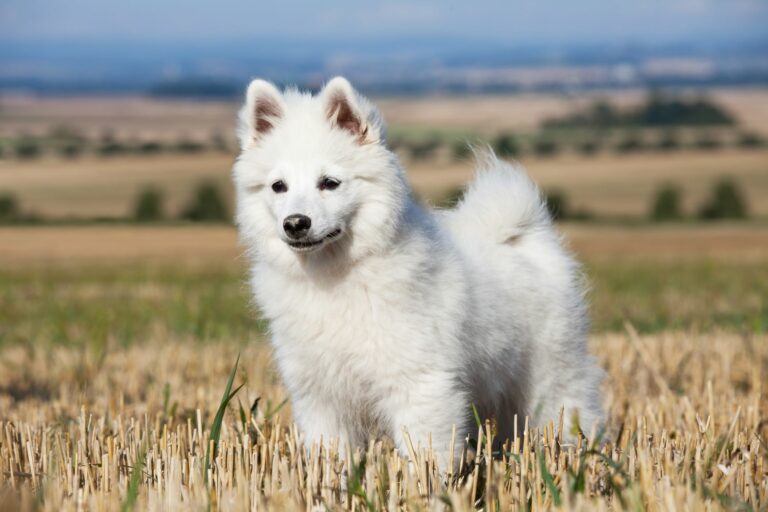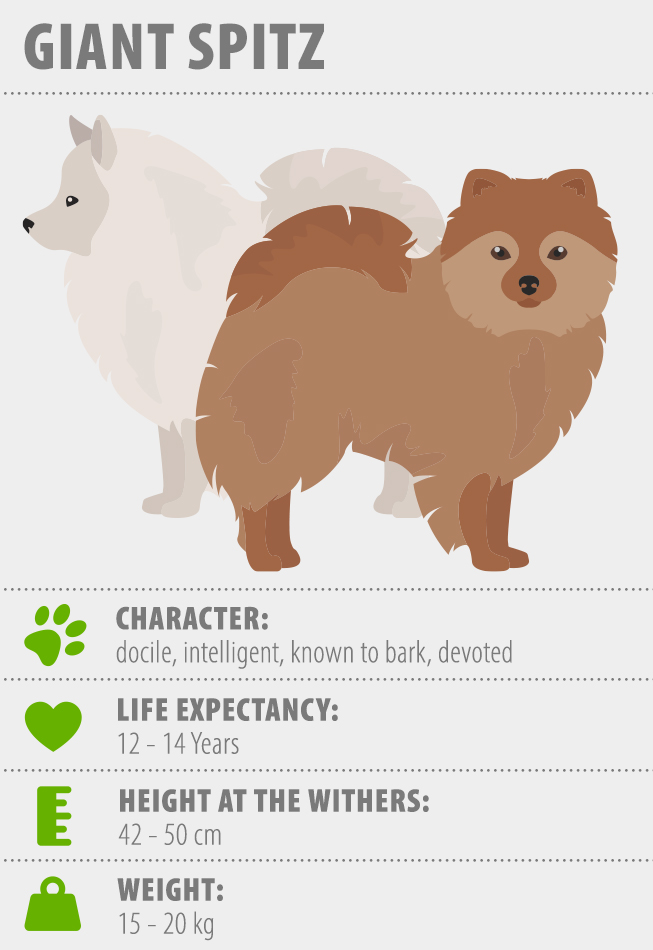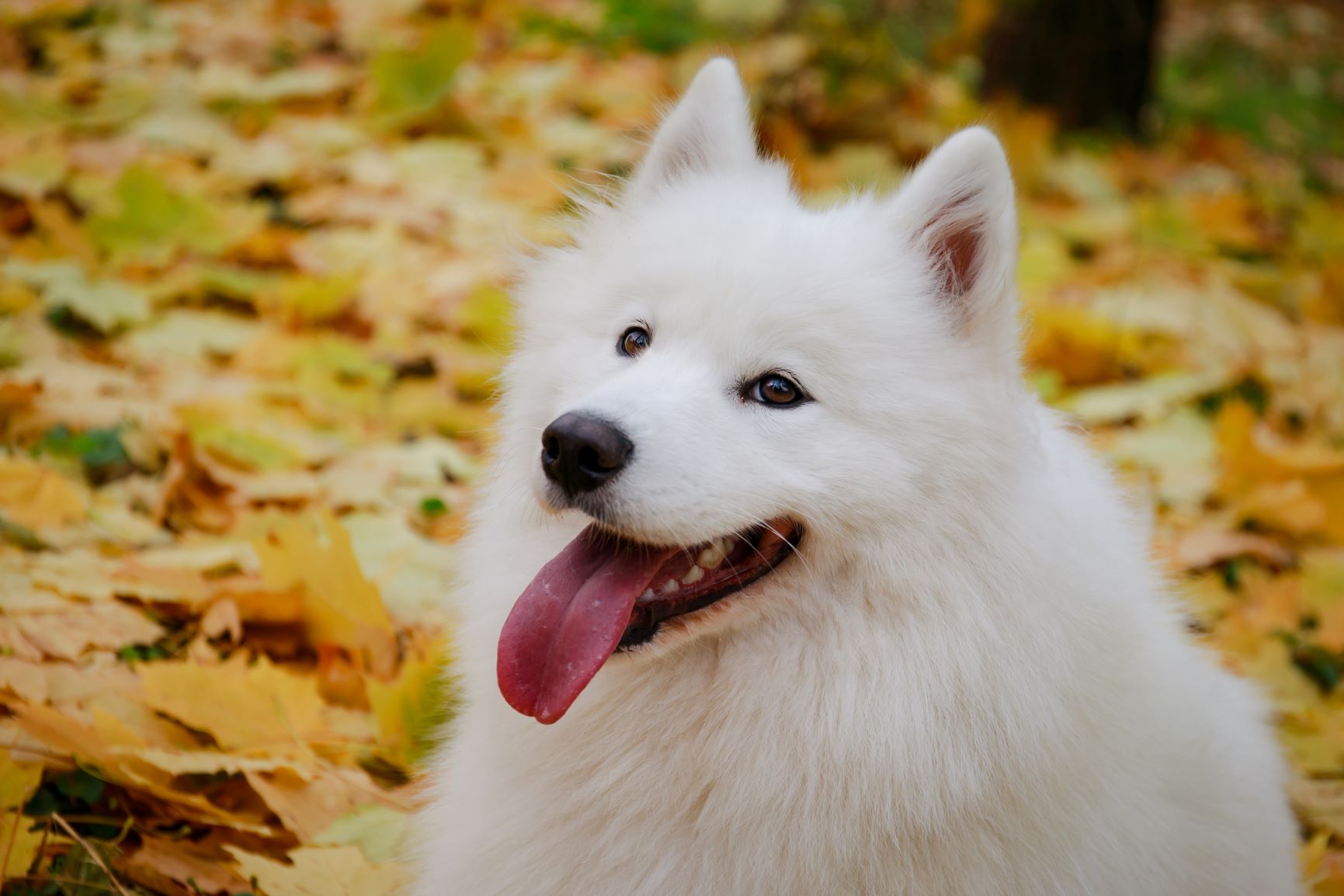Beagle
The Beagle's short legs can be deceiving – this medium-sized dog keeps you on your toes and is always full of surprises! This friendly breed is active, fearless and extremely clever.
The German Spitz is a dog breed that comes in many different varieties. One of these is the rare Giant Spitz, which we would like to introduce in the following article.

© lenkadan / stock.adobe.com
The Giant Spitz looks like a typical Spitz: It has a curled tail and small upright ears.
The Giant Spitz looks like a typical Spitz, meaning it has a curled tail and small upright ears. Its snout resembles a fox’s. The standard attributes to all sizes of Spitz a perky expression, which we of course observe in the docile Giant Spitz too. With a shoulder height of 42 to 50 centimetres, this ‘giant’ Spitz is actually a medium-sized dog. Hence, it is smaller than the Keeshond, which is also classed as a German Spitz. Its thick, long and abundant coat can be black, white or brown. It is always monotone and should not have any markings, spots or yellow stains. The top coat stands out easily due to the abundant undercoat. Giant Spitzes have an extremely hairy collar around their throat. The tail is also long and hairy.
 © zooplus
© zooplus
Spitzes are considered classic farm dogs and have corresponding character traits.
As passionate watchdogs, Giant Spitzes have a close connection to their two-legged pack and territory. So it’s unlikely that a Spitz will run away to explore the area on its own. Although it doesn’t move far away from its loved ones, the Giant Spitz is a temperamental dog that likes exercise. However, strangers aren’t very interesting for this breed. It is often intolerant towards dogs that it isn’t familiar with. Unlike Asian Spitzes, German Spitz varieties hardly hunt at all, although mice, rats and other rodents can feature amongst their prey.
Training a Giant Spitz is doable if you show some patience and lenience. Although this breed is considered obedient and intelligent, unconditional subordination cannot be expected from it. Although it loves its human family, the Giant Spitz knows its own mind and can be stubborn. As a result, it can take slightly longer for this breed to learn basic obedience. As a watchdog, the Giant Spitz likes barking. You will never be able to train this out of the breed – it is part of its nature. When training young dogs, try to steer their barking in the right direction, i.e. it can make noise when there are developments in its territory without succumbing to yapping. Good socialisation with fellow canines is also important so that trips out don’t become a case of running the gauntlet.
The abundant coat and farm dog characteristics place certain demands on dog lovers interested in a Giant Spitz.
As primitive as this breed may be, its owners should take some pleasure in grooming. The soft coat of young dogs in particular requires plenty of combing and brushing. Even adult Giant Spitzes should be thoroughly brushed every few days. Make grooming a ritual from when your dog is a puppy. If your dog associates brushing with something positive, the shared grooming sessions will strengthen the bond between you and your Giant Spitz. This breed likes being outdoors whatever the weather. Unfortunately plenty gets stuck in the thick coat and when it gets wet, the Giant Spitz brings a lot of dirt home. So you should be prepared for that. Regarding dirt, this is of course more visible on white dogs than on black or brown ones. Nevertheless, it’s often sufficient to brush out the dried dirt. You should only give your Giant Spitz a bath in exceptional cases.
The Giant Spitz feels happiest in the countryside. It’s the ideal dog for living on a farm or an estate with a large property, which it will lovingly guard. An apartment in a block of flats could become problematic due to its love of barking alone. Despite their good guard dog qualities, these friendly canines need a family connection and aren’t suitable for living outdoors solely as watchdogs! This breed gets on wonderfully with children, if small children are gently accustomed to living with a dog. Living with cats is often all the more harmonious the earlier the Giant Spitz has had positive experiences with felines. The breed is also considered ‘poultry-friendly’ – an important quality for farm dogs! However, you cannot assume the same devotion towards small pets like guinea pigs.
You’ve probably already guessed that the favourite pastime of the Giant Spitz is standing guard. This role has been in its blood for centuries. Be it on a farm or vineyard, it will be there standing guard! Due to its intelligence, it is also suitable for different types of dog sport like agility or learning tricks. However, you shouldn’t be too ambitious when it comes to competitions. Although the Giant Spitz likes working with you, it keeps its own counsel. So for dog sport, whatever it likes is allowed. This breed can be a good running or jogging companion. Bear its thick fur in mind in summer though and take it slowly with temperatures above 20ºC.
 © kinomaster / stock.adobe.com
© kinomaster / stock.adobe.com
Giant Spitzes from reputable breeders are robust, long-living dogs. With a good diet and sufficient exercise, they remain fit and agile in old age. Due to strict selection of suitable breeding animals, the risk of hereditary diseases like hip dysplasia is very low. There is a tendency for some Spitzes to suffer from Alopecia X (also known as black skin disease), coat loss with no known cause. It begins at two to five years of age. Affected dogs are healthy apart from bald, often black pigmented areas. Twelve years is the average life expectancy of a Giant Spitz, although it’s no rarity for fit dogs from this breed to reach 14 and 15 years of age.
While the Giant Spitz used to be the prototype of a common farm dog, it is now a real rarity. If you buy a Giant Spitz puppy, you are supporting the continued existence of an endangered dog breed.
If you buy a Giant Spitz from a reputable breeder, you aren’t just getting a lovable companion. It also contributes to maintaining this Spitz variety and stabilising the population. You will find the majority of the few breeders in Germany. There are isolated breeders in the Czech Republic, Slovakia and the Netherlands. In some other European countries such as Britain, the Giant Spitz is no longer a recognised German Spitz variety. Some breeders limit themselves to one fur colour and only breed white or black Spitzes. Although the rumour that coat colour has an effect on the character always circulates, most breeders are unable to confirm this. So choose based on your preference.
Do you like Giant Spitzes? Then you will probably also like other Spitzes such as the slightly bigger Keeshond. It is more difficult to train than a Giant Spitz and more demanding in terms of grooming. Of course Miniature, Standard and Pomeranian Spitzes are also options. Other interesting breeds for Spitz fans are Eurasians, which are slightly bigger and very well suited family dogs. The Samoyed isn’t just significantly bigger, but more demanding in terms of training. Interesting Nordic Spitzes are the Finnish Spitz and Swedish Lapphund, although both need a great deal of exercise.
The Giant Spitz is a typical farm dog and has been for centuries. It probably isn’t a descendant of the peat dog, as long assumed. White Spitzes were more common in northern Germany and Poland. They were also popular in some aristocratic homes due to their elegant, unusual appearance and made the jump to America as the German Spitz. There was an image problem there after the First World War, therefore the breed was renamed the Eskimo Spitz. The black Giant Spitz, which is more common in the south, was also called the Vineyard Spitz as a guardian of vineyards. Giant Spitzes have been at risk of extinction for a long time, since many dog lovers prefer the smaller varieties like the Miniature Spitz or Pomeranian. The breed is considered under extreme threat – rarest of all is the brown Giant Spitz.
If you’re looking for a family dog with character and value the Giant Spitz’s watchdog qualities, you’ve found a wonderful companion in this breed. It will accompany you through the wind and rain, but also enjoys snuggling with you on the sofa. We think it’s time to rediscover this centuries-old German Spitz variety!
The Beagle's short legs can be deceiving – this medium-sized dog keeps you on your toes and is always full of surprises! This friendly breed is active, fearless and extremely clever.
The Golden Retriever is still one of the most popular dog breeds, especially with families. It is defined not just by its docility, but shows numerous other qualities too. Read in the following article everything you need to know about the Golden Retriever.
The German Shepherd is one of the most popular utility dog breeds in the world, though the willing-to-learn and people-focused nature of these versatile dogs also makes them suitable for family life.